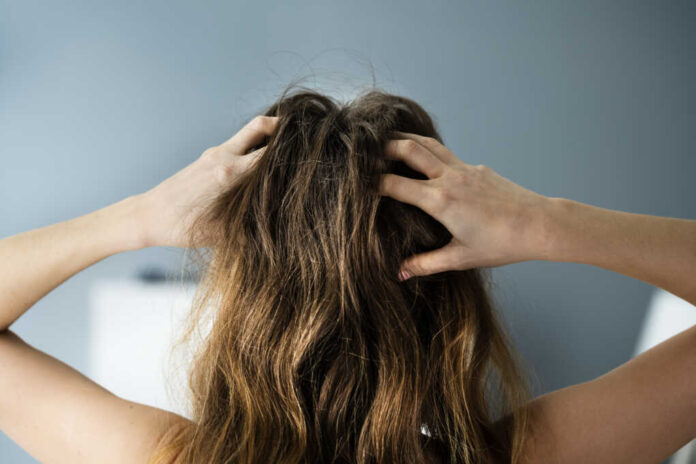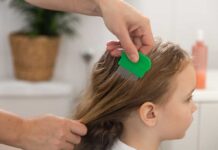
Balancing oily roots with dry, frizzy hair can feel like an impossible task, but understanding the causes and implementing targeted solutions can transform this common hair challenge into a manageable condition.
At a Glance
- Combination hair with oily scalp and dry ends is a common condition caused by an imbalance in sebum production, genetics, and environmental factors
- Over-washing can worsen oil production, while under-washing may lead to buildup; most experts recommend shampooing 2-3 times weekly
- Using sulfate-free, seboregulating shampoos for the scalp while applying moisturizing treatments only to the ends helps maintain balance
- Hard water, heating tools, and climate conditions can exacerbate the oily scalp/dry ends problem
- A balanced diet and proper hair brushing techniques help distribute natural oils from roots to ends
Understanding Combination Hair
Combination hair presents a unique challenge for those over 40, when hormonal changes can further complicate hair care. This hair type features excessive oil production at the scalp while the hair ends remain dry and prone to frizziness. The condition occurs when sebaceous glands in the scalp produce excess sebum, but this natural oil fails to travel down the hair shaft to nourish the ends. Symptoms include roots that become oily soon after washing and brittle, frizzy ends that are prone to breakage and split ends.
Several factors contribute to this condition, including genetics, overwashing, harsh weather exposure, and excessive use of heating tools. Age-related changes can also affect oil production and distribution, making this condition more common among adults over 40. Additionally, hormonal fluctuations during perimenopause and menopause can significantly alter hair texture and sebum production, making a balanced approach to hair care even more essential.
Finding the Right Washing Balance
One of the most challenging aspects of managing combination hair is determining how often to wash it. Washing too frequently can strip the scalp of natural oils, triggering the sebaceous glands to produce even more oil to compensate. Conversely, washing too infrequently allows oil to build up, weighing down roots while leaving ends parched. The key is finding your personal balance, which may require some experimentation.
When selecting shampoo, look for products labeled “seboregulating” or formulated for combination hair. These products help balance oil production without over-drying the scalp. Ingredients like AFFIPORE™, derived from Barosma betulina leaves, can control sebum production without causing irritation. For mature hair that may be thinning, avoid heavy products that could weigh hair down further while still providing necessary moisture to the ends.
Strategic Product Application
How you apply hair products matters just as much as which products you choose. When shampooing, focus on the scalp and roots where oil accumulates. Use gentle, circular motions to cleanse thoroughly without stimulating additional oil production. After rinsing, apply conditioner only from the mid-lengths to the ends of your hair, avoiding the scalp entirely. This targeted approach ensures dry areas receive moisture while preventing additional oil buildup at the roots.
For those dealing with hard water, which can exacerbate both oily roots and dry ends, consider installing a showerhead filter. Hard water contains minerals that can build up on the hair, making the scalp oilier while leaving strands dry and brittle. Using a clarifying shampoo once weekly can help remove mineral buildup, followed by a hydrating mask applied only to the lengths and ends to restore moisture balance without weighing down roots.
Beyond Products: Lifestyle Factors
Managing combination hair extends beyond product selection to include lifestyle habits. Frequent touching of the hair can transfer oils from fingers to hair, increasing oiliness at the roots. Similarly, using the same pillowcase for extended periods allows oils to be redeposited onto hair and skin. Changing pillowcases twice weekly and using silk or satin cases can reduce friction and oil transfer, benefiting both hair and aging skin.
Diet also plays a significant role in hair health. Excessive consumption of fried, fatty, or sugary foods can increase sebum production, while nutritional deficiencies can contribute to dry, brittle ends. For adults over 40, ensuring adequate intake of omega-3 fatty acids, vitamin E, and biotin becomes particularly important as these nutrients support healthy oil production and hair strength. Staying well-hydrated further supports overall hair health, helping to maintain the natural moisture balance from roots to ends.
Simple Home Solutions
Several home remedies can help manage combination hair between washes. Apple cider vinegar rinses (one part vinegar to four parts water) help remove product buildup and balance scalp pH without stripping natural oils. For immediate relief from oily roots, natural dry shampoos made with cornstarch or rice powder absorb excess oil without the harsh chemicals found in many commercial products. Aloe vera gel applied to the ends provides lightweight moisture that won’t weigh hair down.
Proper brushing technique also helps manage combination hair by distributing natural oils from the scalp to the drier ends. Use a natural bristle brush and brush from roots to tips in continuous strokes. This simple habit, performed nightly, can significantly improve hair texture over time by helping natural oils reach the areas where they’re needed most, reducing both oiliness at the roots and dryness at the ends.


















